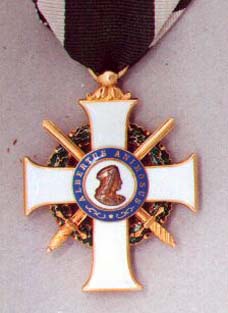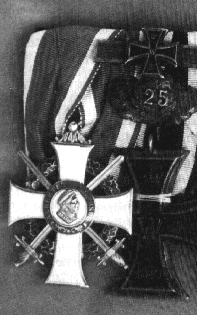|
(Published in Orden
Militaria Magazin of BDOS e.V. No. 73)
Issued on December 31, 1850 the Order
of Albert was awarded in its initial design until January
31, 1876.
Until then the decorations varied to its successor in
the design of the medallion and in only few but particular details. Conspicuous
however are the swords witch were awarded for merit
during the wars of 1866 and 1870/71.
|

Picture 1 |

Pict.3 knight cross made by Rothe,
medallion already changed |
|
 Pict.2 reverse
Pict.2 reverse |

Pict.4 reverse |
|

different swords fixing vs. pict. 1 &
2 |
There are
three different types. The first type is shown in
Picture 1 and 2. It is the most common type made
by the jeweler Moritz Elimeyer in Dresden. A different
type was made by Rothe in Vienna. This type varies
totally in its style and is the rarest one, because it
was officially produced only during the war in 1866 (Picture 3-4).
Most of these particular decorations show makers marks.
The last type, published in OMM No. 46 Page 26,
comes without markings (Picture 5).
|

Picture 5 |
All those types have
some thing in common. The swords are
all attached to the oak leaf wreath with little cramps and
are chased on the reverse of their handles in fine
detail.
In
contrary
to the decorations for merit in peace time, the war
decorations are very rare. After they have been issued
on October 29, 1866, they were awarded during the wars
of 1866 and 1870/71, only.
All
together 83 decorations were awarded: 14 in the
1866 war and 69 during the Franco Prussian war 1870/71.
The numbers are set together as follows:
|
Order of Albert 1.Model |
1866
|
1870/71 |
|
Grand
Cross with Swords |
(0) 3
|
(0) 6
|
|
Commanders Cross 1. Class with Swords |
(1) 5
|
(1) 7
|
|
Commanders Cross 2. Class with Swords |
(2) 6
|
(7) 52
|
() to Saxons,
without () to foreigners
Sources:
"Staatshanbuch für das Königreich
Sachsen. 1867.", Dresden 1867, S.44-78.
"Staatshanbuch für das Königreich
Sachsen. 1873.", Dresden 1873, S.77-155.
Staatarchiv Dresden - Sächsische
Ordenskanzlei, Matrikel des Albrecht-Ordens Nr.16 und
17.
© A. Schulze Ising, II/99
| 




